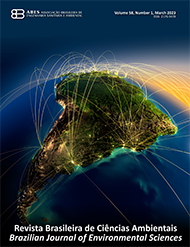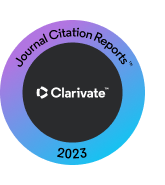Evaluation of the acute phytotoxicity of phototreated textile effluent using cucumber (Cucumis sativus) and radish seeds (Raphanus sativus)
DOI:
https://doi.org/10.5327/Z2176-94781861Keywords:
bioindicator; dye; ecotoxicity; photocatalyst.Abstract
Water, as a vital resource, plays a crucial role in human activities, notably in the textile industry, whose operations can significantly impact the quality of this resource. It is imperative to explore solutions, such as the adoption of advanced oxidative processes, which encompass the degradation of dyes present in effluents through the action of hydroxyl radicals. To evaluate the effectiveness of this treatment, acute phytotoxicity tests are carried out to analyze the responses of plant organisms to the effluents. Therefore, this study aimed to assess the acute phytotoxicity of a natural textile effluent subjected to heterogeneous photocatalysis and homogeneous photo-fenton treatments. Acute phytotoxicity tests were performed with cucumber (Cucumis sativus) and radish (Raphanus sativus) seeds, both for the treated effluent and in natura. The results revealed a sensitivity of cucumber seeds to effluent in natura and resistance to radish seeds. Regarding the phototreated effluents, the results showed an increase in seed germination rate and contributed to enhance this germination. Phytotoxic tests were also carried out with sodium chloride and sodium sulfate, and the toxicity of these substances to cucumber and radish seeds was confirmed.
Downloads
References
Al-Ansari, M. M.; Li, Z.; Masood, A.; Rajaselvam, J., 2022. Decolorization of azo dye using a batch bioreactor by an Indigenous bacterium Enterobacter aerogenes ES014 from the wastewater dye effluent and toxicity analysis. Environmental Research, v. 205, 112189. https://doi.org/10.1016/j.envres.2021.112189.
Associação Brasileira da Indústria Têxtil (ABIT), 2022. Indústria têxtil e de confecção faturou R$ 194 bilhões em 2021 (Accessed August 18, 2023) at:. https://www.abit.org.br/noticias/industria-textil-e-de-confeccao-faturou-r-194-bilhoes-em-2021.
Cesário, G.C., 2017. Fitotoxicidade de efluente de tingimentos têxteis realizados com ciclodextrina. Trabalho de conclusão de curso, Universidade Tecnológica Federal do Paraná, Apucarana. Retrieved 2017-12-01, from http://repositorio.utfpr.edu.br/jspui/handle/1/5730
Dhaouefi, Z.; Toledo-Cervantes, A.; Ghedira, K.; Chekir-Ghedira, L.; Muñoz, R., 2019. Decolorization and phytotoxicity reduction in an innovative anaerobic/aerobic photobioreactor treating textile wastewater. Chemosphere, v. 234, 356-364. https://doi.org/10.1016/j.chemosphere.2019.06.106.
Dutta, S.; Bhattacharjee, J., 2022. A comparative study between physicochemical and biological methods for effectively removing textile dye from wastewater. In: Shah, M.P.; Rodriguez-Couto, S.; Kapoor, R.T. Development in Wastewater Treatment Research and Processes. Elsevier, Haldia, India, pp. 1-21. https://doi.org/10.1016/B978-0-323-85657-7.00003-1.
Engelhardt, M.M.; Lima, F.R.D.; Martins, G.C.; Vasques, I.C.F.; Silva, A.O.; Oliveira, J.R.; Reis, R.H.C.L.; Guilherme, L.R.G.; Marques, J.J.G.S.M, 2020. Fitotoxicidade do cobre em culturas agrícolas cultivadas em solos tropicais. Semina: Ciências Agrárias, Londrina, v. 41 (6), Suplemento 2, 2883-2393. https://doi.org/10.5433/1679-0359.2020v41n6Supl2p2883.
Hadjadj, S.; Sekerifa, B.B.; Khellafi, H.; Krama, K.; Rahmani, S.; El Hadj-Khelil, A.O., 2022. Salinity and type of salt affect seed germination characteristics of the medicinal plant Zygophyllum album L. (Zygophyllaceae), native to the Algerian Sahara. Journal of Applied Research on Medicinal and Aromatic Plants, v. 31, 100412. https://doi.org/10.1016/j.jarmap.2022.100412.
Hoss, L.; Loebens, L.; Dos Santos, N.R.; Schoeler, G.P.; Silveira, M., 2019. Efeito da ozonização na fitotoxicidade de lixiviado de aterro sanitário. Congresso Sul-Americano De Resíduos Sólidos e Sustentabilidade (ConReSol); 2019 30-May; Foz do Iguaçu, Brazil. 1-6 p.
Li, M.; Li, K.; Wang, L.; Zhang, X., 2020. Feasibility of concentrating textile wastewater using a hybrid forward osmosis-membrane distillation (FO-MD) process: Performance and economic evaluation. Water Research, v. 172, 115488. https://doi.org/10.1016/j.watres.2020.115488.
Ma, D.; Yi, H.; Lai, C.; Liu, X.; Huo, X.; An, Z.; Yang, L., 2021. A critical review of advanced oxidation processes in organic wastewater treatment. Chemosphere, v. 275, 130104. https://doi.org/10.1016/j.chemosphere.2021.130104.
Mohamed, W.A.; Abd El-Gawad, H.H.; Handal, H.T.; Galal, H.R.; Mousa, H.A.; Elsayed, B.A.; Abdel-Mottaleb, M.S.A., 2023. TiO2 quantum dots: Energy consumption cost, germination, phytotoxicity studies, recycling photo and solar catalytic processes of reactive yellow 145 dye and natural industrial wastewater. Advanced Powder Technology, v. 34 (1), 103923. https://doi.org/10.1016/j.apt.2022.103923.
Moraes Júnior, J.R.; Bidoia, E.D., 2015. Color degradation of simulated textile effluent by electrolytic treatment and ecotoxicological evaluation. Water Air Soil Pollution, v. 226, 402. https://doi.org/10.1007/s11270-015-2665-2.
Nidheesh, P.V.; Ravindran, V.; Gopinath, A.; Kumar, M.S., 2022. Emerging technologies for mixed industrial wastewater treatment in developing countries: an overview. Environmental Quality Management, v. 31 (3), 121-141. https://doi.org/10.1002/TQEM.21762.
Oyeniran, D.O.; Sogbanmu, T.O.; Adesalu, T.A., 2021. Antibiotics, algal evaluations, the acute effects of abattoir wastewater on liver function enzymes, genetic and haematologic biomarkers in the freshwater fish, Clarias gariepinus. Ecotoxicology and Environmental Safety, v. 212, 111982. https://doi.org/10.1016/j.ecoenv.2021.111982.
Peduto, T.A.G.; Jesus, T.A.D.; Kohatsu, M.Y., 2019. Sensibilidade de diferentes sementes em ensaio de fitotoxicidade. Revista Brasileira de Ciência, Tecnologia e Inovação, v. 4, (2), 200-212. https://doi.org/10.18554/rbcti.v4i2.3698.
Rahmani, A.R.; Mousavi-Tashar, A.; Masoumi, Z.; Azarian, G., 2019 Integrated advanced oxidation process, sono-Fenton treatment, for mineralization and volume reduction of activated sludge. Ecotoxicology and Environmental Safety, v. 168, 120-126. https://doi.org/10.1016/j.ecoenv.2018.10.069.
Rocha, E.M.R.; Lucena, L.G.; de Almeida Porto, C., 2020. Otimização do processo foto-fenton solar no tratamento de lixiviados de aterros sanitários. Revista Tecnologia e Sociedade, v. 16 (41), 202-215. https://doi.org/10.3895/rts.v16n41.11797.
Samuchiwal, S.; Gola, D.; Malik, A., 2021. Decolorization of textile effluent using native microbial consortium enriched from textile industry effluent. Journal of Hazardous Materials, v. 402, 123835. https://doi.org/10.1016/j.jhazmat.2020.123835.
Saravanakumar, K.; De Silva, S.; Santosh, S.S.; Sathiyaseelan, A.; Ganeshalingam, A.; Jamla, M.; Wang, M.H., 2022. Impact of industrial effluents on the environment and human health and their remediation using MOFs-based hybrid membrane filtration techniques. Chemosphere, v. 307, 135593. https://doi.org/10.1016/j.chemosphere.2022.135593.
Singha, K.; Pandit, P.; Maity, S.; Sharma, S.R., 2021. Harmful environmental effects for textile chemical dyeing practice. In: Ibrahim, N.; Hussain, C.M. Green Chemistry for Sustainable Textiles. Woodhead Publishing, Patna, pp. 153-164. https://doi.org/10.1016/B978-0-323-85204-3.00005-1.
Soares, M.R.; Matsinhe, C.; Belo, S.; Quina, M.J.; Quinta-Ferreira, R., 2013. Phytotoxicity evolution of biowastes undergoing aerobic decomposition. Journal of Waste Management, v. 2013 (1), 479126. https://doi.org/10.1155/2013/479126.
Sobrero, M.C.; Ronco, A., 2004. Ensayo de toxicidade aguda com semillas de lechuga (Lactuca sativa L). In: Castillo, G. (Ed.), Ensayos toxicológicos y métodos de evaluación de calidad de águas. International Development Research Centre (IDRC), Ottawa, pp. 71-79.
Türkyilmaz, M., 2022. A comparative study of free chlorine activated by Fe+ 2 and U.V. C light catalysts in treating real and simulated textile wastewater: Optimization, reactive species, and phytotoxicity assessment. Journal of Water Process Engineering, v. 49, p. 103161. https://doi.org/10.1016/j.jwpe.2022.103161.
Viana, G.C.C.; Rocha, E.M.R.; Scapin, E.; Cahino, A.; Leite, I.R.D.; Bertuol, D. A.; Amorim, C.C., 2023. Solar photocatalysis using post-consumer alkaline batteries degrades contaminants of emerging surface water concerns. Journal of Environmental Chemical Engineering, v. 11, (6), 111226. https://doi.org/10.1016/j.jece.2023.111226.
Waghmode, T.R.; Kurade, M.B.; Sapkal, R.T.; Bhosale, C.H.; Jeon, B.H.; Govindwar, S.P., 2019. Sequential photocatalysis and biological treatment for the enhanced degradation of the persistent azo dye methyl red. Journal of Hazardous Materials, v. 371, 115-122. https://doi.org/10.1016/j.jhazmat.2019.03.004.
Zucconi, F. (Ed.)., 1981. Regulation of abscission in growing fruit. Symposium on Growth Regulators in Fruit Production; 1981 30- Jun; Ithaca, USA. ISHS Acta Horticulturae 120: L.C. Luckwill. 89-94 p.
Zou, H.; Ning, X.A.; Wang, Y.; Zhou, F., 2019. The agricultural use potential of the detoxified textile dyeing sludge by integrated Ultrasound/Fenton-like process: a comparative study. Ecotoxicology and Environmental Safety, v. 172, 26-32. https://doi.org/10.1016/j.ecoenv.2019.01.020.
Published
How to Cite
Issue
Section
License
Copyright (c) 2024 Revista Brasileira de Ciências Ambientais

This work is licensed under a Creative Commons Attribution 4.0 International License.


























